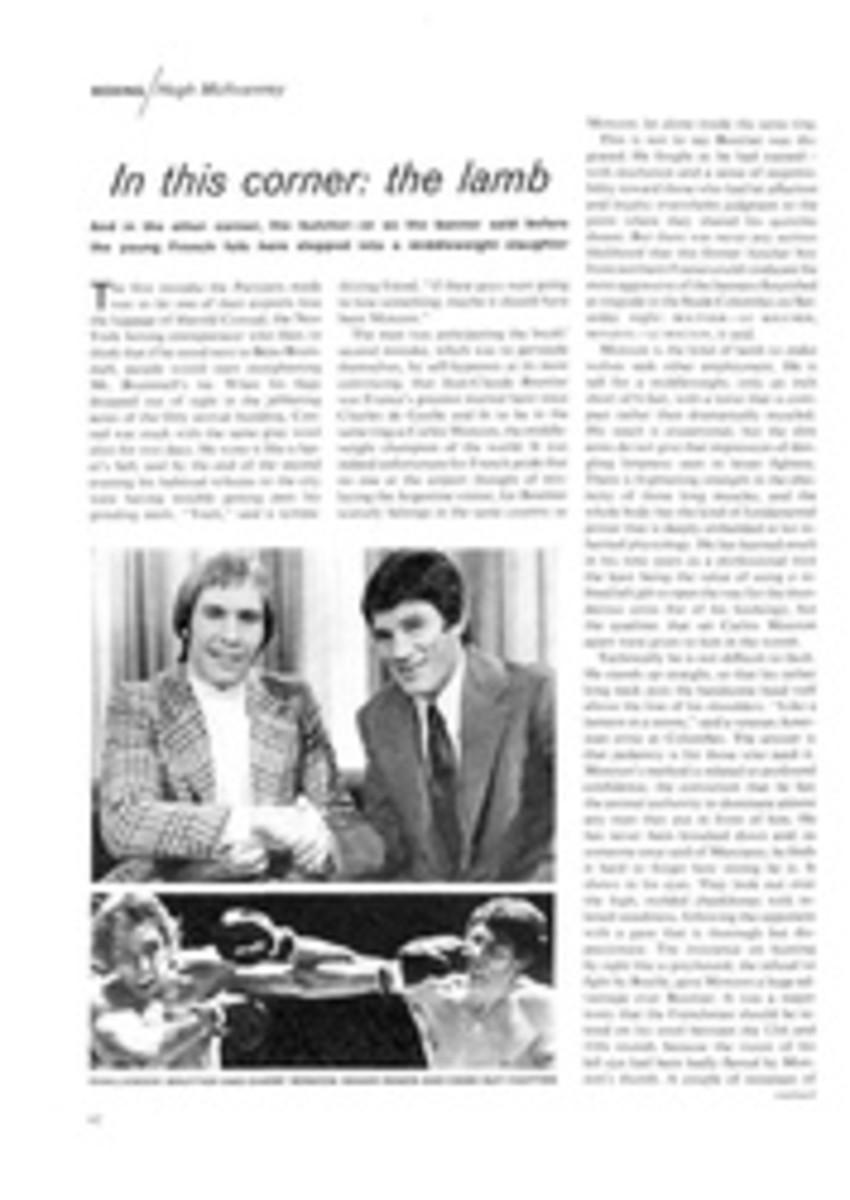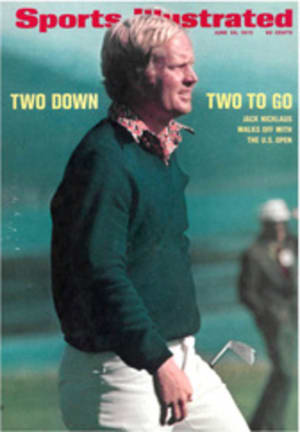
Hail the Trinity twosome
Five hot days and close to 2,500 balls had been used up last week in the NCAA tennis championship before it came time for the singles final Saturday morning. The bleachers flanking court No. 1 at the University of Georgia in Athens were jammed with spectators risking sunburn, and hundreds more risked chigger bites to watch from the steep hillside above one end. The pair of tanned finalists, both as taut as racket gut—and both from Trinity University—were introduced. One was four-time All-America Dick Stockton, a native of Garden City, N.Y., the top seed. Across the net: sophomore and two-time All-America Brian Gottfried from Fort Lauderdale, Fla., Stockton's roommate. After approximately 90 practice sets against each other, they had traveled all the way from San Antonio, Texas to play an intrasquad match for the national championship. Ridiculous.
It was that kind of happy hoggish week for the Trinity Tigers, NCAA runners-up the previous two years. They marched into Georgia as heavy favorites, winners of 36 dual matches in a row, so strong that their No. 4 player, Paul Gerken, was picked for the Davis Cup team.
Tennis Tech lived up to its publicity handouts. There were 185 men from 56 colleges entered in the singles, but four of the eight quarterfinalists were from Trinity. Trinity's No. 3 man, Bob McKinley, won the Osuna Memorial Trophy for sportsmanship, competitive excellence and contributions to tennis. The Tigers clinched the team title Friday morning and when Stockton beat his pal Gottfried in four sets Saturday the team point total rose to a record 36. And Trinity achieved something else of note: it was the first time in 13 years that USC or UCLA did not win the tournament.
Actually, Trinity's only stiff competition came from a third California school, Stanford, which had beaten UCLA in a dual match this season for the first time in 30 years. Stanford's most impressive weapon was the first serve of lefty Roscoe Tanner, a junior from Lookout Mountain, Tenn. This particular shot sends linesmen scattering for cover. Tanner and teammate Alex Mayer reached the singles semifinals before losing to Stockton and Gottfried, and teamed up to win the doubles, beating Trinity's Gerken and Gottfried Saturday afternoon.
But the show was Trinity's, and nobody enjoyed it more than Coach Clarence Mabry, the architect of Tennis Tech. Mabry grew up in Alice, Texas, an oil town 40 miles from Corpus Christi. In Alice, a backhand is what your daddy gives you for being smart-alecky. As a boy he sold what he thought were enough Saturday Evening Post subscriptions to earn himself a bicycle and he mailed off for it. The Post disappointed him by sending a tennis racket instead. His high school did not even have a team and Corpus Christi was the nearest place to practice. Nevertheless, Mabry became the state high school champion, Southwest Conference singles and doubles champion for the University of Texas and an NCAA doubles finalist. After graduation he worked as a salesman in San Antonio and dabbled in semipro baseball and weekend tennis tournaments.
In 1956 he became the coach at Trinity, a small Presbyterian school built on the site of an old rock quarry. (A sheer, 40-foot stone bluff bisects the pretty campus.) His first team was a gathering of local municipal-court habitués, three of whom were sons of bus drivers. From that beginning he has built a small empire. He is now part owner of the T-Bar-M tennis ranch in New Braunfels, Texas, where Australian John Newcombe is the pro, and he has a stake in a posh indoor club in Dallas. His Trinity Tigers have had 17 winning seasons, and his program is self-supporting enough that when the school administration decided to stop giving athletic grants-in-aid starting in September, tennis was exempted.
But one goal that had eluded Mabry was an NCAA championship. He had missed as a player and a coach, though the latter failure was partly his own fault. In 1963, for instance, Trinity was filled to the rim of its rocky cliff with talent, including the country's first-and second-ranked amateurs, Chuck McKinley and Frank Froehling, plus Cliff Buchholz and Butch Newman. Mabry elected to skip the NCAAs and instead take his aces to Wimbledon, where McKinley won. McKinley and Froehling went to England every year and never saw the NCAA tournament.
Trinity finished a close second to UCLA the last two years, and with four All-Americas returning Mabry knew he now had his best shot at first place, especially since UCLA had lost two undergraduate stars, Jimmy Connors and Haroon Rahim, to the pros. Still, he took no chances. For the three nights before departure, he had his men come to his house for steak dinners. Since school was out, he knew they would subsist on cheeseburgers and French fries otherwise.
The matches were held on recently resurfaced Laykold Courts, just like those at Tennis Tech. The tourney director, public-address announcer, publicist and seller of slightly used match balls was Georgia Tennis Coach Dan Magill, who grew up near the campus. As a youngster he did not sell Post subscriptions; he tended the school's old red-clay courts. In the depths of the Depression he promoted what promised to be an epic battle there: a fight to the death between a king snake and a timber rattlesnake—admission one dime. The only trouble was the reptiles were so afraid of the spectators, or each other, that they would not fight or even let out a respectable hiss. Magill gave no refunds.
The death struggles in this latest Magill promotion were somewhat more satisfying, especially to Trinity. Perhaps the most surprising was between Paul Gerken and Miami's Eddie Dibbs, the tournament's No. 2 seed who had been unbeaten in singles all season. Indeed, he had lost only one set. Gerken beat him in the fifth round 6-2, 6-2. Dibbs had suffered a stomach ailment before the tournament started, but the upset still was a much-needed morale booster for Gerken, a handsome, husky blond who is so shy the linesmen bark at him. He had played well as a freshman at Stanford, but became dissatisfied and transferred to Trinity, only to find himself playing fourth fiddle.
"It is really discouraging," he said. "The quality of opposition isn't that good when you're No. 4, and sometimes I would go three or four weeks and not have to extend myself at all in a match. Then when a tournament would come up, I wouldn't be ready."
The best match of the week was the semifinals singles between Stockton and Tanner, who had reached the NCAA final as a freshman and as a sophomore. Gottfried already had locked up the title for Trinity by beating Stanford's Alex Mayer in straight sets 7-6, 6-1, 6-2, so Stockton and Tanner had no team pressure on them. But the pressure of their own ambition was enough.
Stockton's serve is considered to be very good, but compared to Tanner's it is a slow-motion shuttlecock. Tanner won two of the first three sets and served 17 aces while doing it. Stockton was so on edge that after one close line call he went over to a bespectacled linesman and wiped the glasses with a towel. He was pained, too, by an aching stomach muscle he had strained in a match a few weeks before.
Tanner seemed to be in control, but after the 10-minute break he served fewer aces and got fewer first serves in. Stockton, experienced and better than Tanner in almost every category, won the last two sets and the match, 7-5, 3-6, 6-7, 6-2, 6-4, to set up the all-Trinity final.
Stockton's stomach muscle bothered him so much the night before the final that he hardly slept. Saturday morning Mabry took Stockton to a doctor, who treated him with a vibrator and ultrasound and plastered a red-hot pad on his belly that was visible through his shirt during the match. Perhaps some of the lost sleep was also due to worries about Gottfried. Four of the last five NCAA singles winners were men rated only second best at their own colleges: Bob Lutz of USC in 1967 (behind Stan Smith), Joaquin Loyo-Mayo of USC in 1969 (behind Bob Lutz), Jeff Borowiak of UCLA, 1970 (behind Haroon Ra-him) and UCLA's Jimmy Connors last year (behind Jeff Borowiak). Would Gottfried be the spoiler this time?
Mabry, happily neutral, kept most of his advice to himself. Gottfried won the first set 4-6 and had Stockton muttering, barking at a ball boy, complaining about the net and throwing his racket down in disgust. But when Gottfried lost the seventh game of the second set on a close line call it was his turn to launch into some fine Pancho Gonzalez imitations: a snarl, a grimace, a glare—all made more terrifying by his Fu Manchu mustache. And he seldom played up to his standard after that, as Stockton took three straight sets 6-4, 6-3, 6-2.
Gottfried returned in the afternoon and joined with Gerken in losing the doubles to Stanford's Mayer and Tanner. Stanford could console itself with the knowledge that it had beaten Trinity in four of seven tournament matches and, even better, that a courtful of the nation's top juniors have signed or are already enrolled for next season. It was rumored that Tanner would turn pro instead of returning for his senior year, but even without his service Stanford should be the 1973 NCAA favorite.
Stockton, with Trinity degree in hand and anxious to start playing for cash, was content to let Coach Mabry and sophomore Gottfried worry about Stanford. Stockton has worries of his own, like Wimbledon and Forest Hills and Rod Laver, and maybe on the way up 200 more matches against Tanner.
"The summer's just getting started," Stockton said, fingering his hot pad as if it were a money pouch, "and I'm getting stronger and stronger."
PHOTO
WINNER DICK STOCKTON (RIGHT) AND HIS OPPONENT-TEAMMATE, BRIAN GOTTFRIED
PHOTO
STANFORD WONT HAVE TO WORRY ABOUT STOCKTON NEXT YEAR, BUT THE PROS WILL

